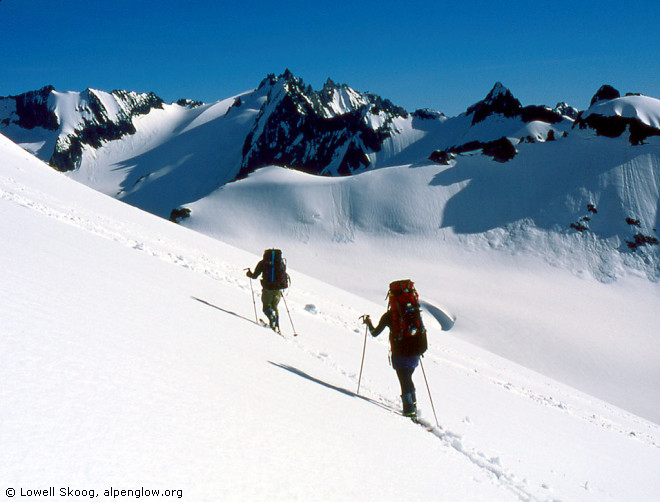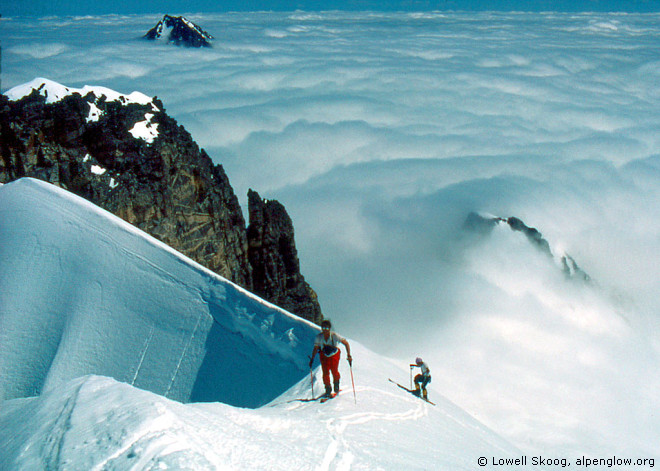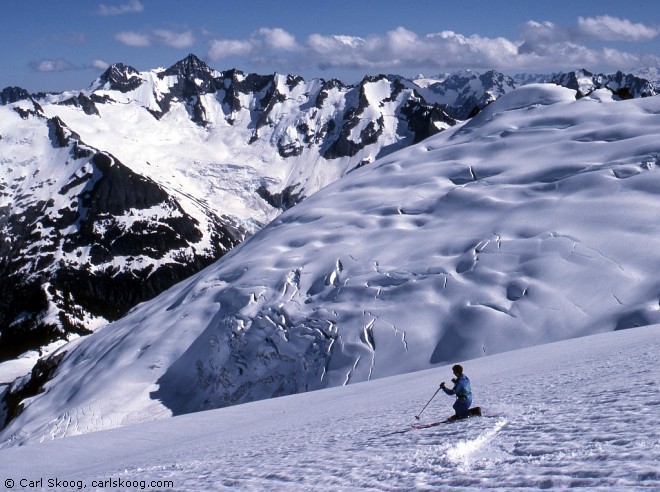Part 1 - Timing
Since I began mountaineering in college I’ve maintained a simple
hand-written journal. This article draws upon my journal notes to distill
what I’ve learned in the past 25 years about skiing Cascade high
routes.
What is a High Route?
- These are routes that go over and across the mountains, not just up
and down a single peak.
- They’re mostly above timberline.
- They can be day trips or multi-day trips.
- For this discussion I’ve included Cascade Crest segments, even
those at fairly low elevations.
- I’ve looked at 53 trips over 26 years.
- A total of 126 days on skis.

|
 |
|
Bruce Goodson and Matt Firth contour above the South Cascade Glacier
on the Ptarmigan Traverse, June 2000.
|
 |
Timing is Everything
- Catching good conditions to ski a Cascade high route can be
difficult, especially for a multi-day trip.
- You can choose a time to go or you can choose a place to go, but
very often you can’t choose both.
- Typically I’ve tried to do high-route trips between mid-April
and mid-June, but I’ve been successful most often just in the
latter half of that period.
- March may have potential, but I haven’t done many trips at
that time.

|
 |
|
Carl Skoog and Jens Kieler ski to the summit of Mt Fury in
the Picket Range, May 1985.
|
 |
Histogram of Trips, 1982-2008
- The following diagram is based on my personal experience.
- I looked through my journal for trips that fit my definition of a
high route and sorted them by date.
- Every trip day is represented by a segment on this bar chart, so you
can quickly see what times of year have worked for me.
- I’ve shown only the trips that I actually completed.
- After some filtering, I ended up with 53 trips over 26 years, a
total of 126 days on skis.
- For a larger view, click here
or the diagram below.
Seasons of the Snow
- The following diagram tries to sketch out some “seasons of the
snow” in the Cascades, correlated with the trips I’ve done.
The model is most applicable to the western part of the North Cascades.
- Wintry Mix (January thru March or early April) —
During this period you typically have either powder or crust depending on
what the latest weather system was like. Occasionally in late winter
you’ll find corn snow.
- Mush (April thru mid May) — As the weather gets
warmer, powder becomes rare, crusts break down, and the snowpack goes
through a mushy phase.
- Consolidated (late May thru June) — Snow quality
and stability improves as the snow gradually consolidates.
- Patchy (July and later) — As the snow becomes
firmer and more patchy, doing high routes on skis becomes less appealing.
Snow Season Transitions
- The following diagram tries to show how the snow seasons overlap and
vary in timing. While the seasons are not as neatly defined as
I’ve drawn them here, some trends are can be observed:
- The seasons progress from low elevations to higher elevations.
- The seasons advance from east to west (nearly always).
- The seasons advance from south to north (usually).
- As a result, Mt Baker and the western part of the North Cascades are
typically the last areas to consolidate.
- Progress is gradual—one good storm can set the clock back,
and this can last for a week or more.
<<Prev
|
Intro
|
Timing
|
Winter
|
Mush
|
Gliding
|
Weather
|
Glaciers
|
Next>>

|



